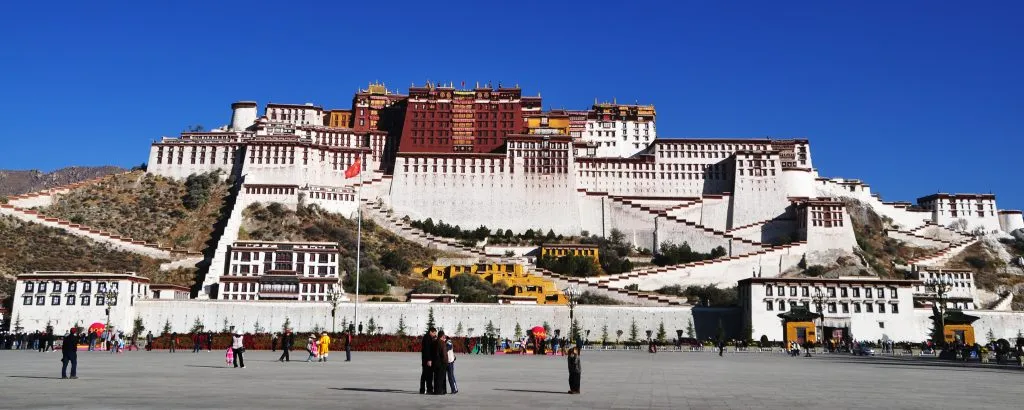A Brief History of Potala Palace
The Potala Palace has a history stretching back over 1,300 years. The original palace was constructed in the 7th century during the reign of King Songtsen Gampo, who built it as a residence and spiritual center. The current structure, however, was mainly rebuilt in the 17th century under the rule of the Fifth Dalai Lama.
For centuries, the Potala Palace served as the winter residence of the Dalai Lamas and the administrative and religious center of Tibet. Today, it stands as a museum and a spiritual pilgrimage site, drawing visitors from all over the globe.
Location and Setting
The palace is dramatically located on Red Mountain in the center of Lhasa. Standing at an elevation of 3,750 meters (12,300 feet), the Potala Palace dominates the skyline with its towering white and red walls, golden roofs, and staircases that seem to climb into the heavens.
Its location offers panoramic views of Lhasa city and the surrounding Himalayas, making it one of the most photographed landmarks in Tibet.
Architectural Brilliance
Potala Palace is not only a religious icon but also a masterpiece of Tibetan architecture.
Structure and Layout
-
White Palace (Potrang Karpo): The administrative section that once housed offices, living quarters, and the seminary for monks.
-
Red Palace (Potrang Marpo): Dedicated to religious study and prayer, containing chapels, shrines, and stupas of past Dalai Lamas.
Key Features
-
Over 1,000 rooms including meditation halls, temples, libraries, and tombs.
-
13 stories high, built into the mountain with thick stone walls for stability.
-
Murals and frescoes depicting Tibetan history, Buddhist teachings, and significant events.
-
Treasures and relics such as rare scriptures, ancient statues, and sacred artifacts.
The palace exemplifies traditional Tibetan architecture, blending seamlessly with the natural mountain landscape.
Cultural and Spiritual Significance
Potala Palace is considered the heart of Tibetan Buddhism and holds immense religious importance. It houses sacred shrines, stupas, and thousands of religious scriptures. Pilgrims from across Tibet and beyond travel long distances to pay their respects, often walking around the palace in devotional prayer circuits known as kora.
As the former residence of the Dalai Lamas, the palace symbolizes the spiritual and political authority once held by Tibetan leaders.
UNESCO World Heritage Site
In 1994, the Potala Palace was designated a UNESCO World Heritage Site, recognizing its cultural, historical, and architectural value. It stands alongside the Jokhang Temple and Norbulingka as part of the “Historic Ensemble of the Potala Palace.”
Visiting Potala Palace
Opening Hours
-
Open daily: 9:00 AM – 4:00 PM
-
Best time to visit: May to October, when the weather is milder.
Ticket Information
-
Tickets are required and often need to be booked in advance due to daily visitor limits (to protect the structure).
-
Foreign travelers usually need to arrange entry through registered tour agencies, as independent travel in Tibet is restricted.
Highlights to Explore
-
Golden Roofs: Sparkling in the sunlight, offering views of Lhasa city.
-
The White Palace: Explore the administrative chambers and living quarters of the Dalai Lamas.
-
The Red Palace: Visit sacred chapels, stupas of former Dalai Lamas, and meditation halls.
-
Murals & Artworks: Intricate paintings illustrating Tibetan Buddhist cosmology and legends.
How to Get There
Since Lhasa lies in the Tibet Autonomous Region, reaching Potala Palace requires careful planning.
-
By Air: Lhasa Gonggar Airport connects to major Chinese cities like Beijing, Chengdu, and Xi’an.
-
By Train: The Qinghai–Tibet Railway provides a scenic (but long) journey into Lhasa.
-
By Tour: International visitors must book through licensed tour operators who provide permits and guides.
Travel Tips for Visiting Potala Palace
-
Acclimatize to Altitude – Lhasa is at high elevation; spend a day resting before visiting.
-
Book in Advance – Entry tickets sell out quickly due to strict daily visitor limits.
-
Respect Religious Customs – Photography is restricted inside; always be mindful of sacred spaces.
-
Dress Modestly – Wear comfortable clothing suitable for climbing stairs and respectful of local traditions.
-
Stay Hydrated & Move Slowly – Thin air makes climbing steep stairs challenging.
Nearby Attractions
When visiting Potala Palace, consider exploring these nearby landmarks in Lhasa:
-
Jokhang Temple – The holiest temple in Tibet, located in Barkhor Square.
-
Norbulingka – The former summer residence of the Dalai Lamas.
-
Barkhor Street – A lively market and pilgrimage route around Jokhang Temple.
Why Visit Potala Palace?
Potala Palace is more than a tourist attraction—it’s a living symbol of Tibetan culture, history, and spirituality. From its breathtaking architecture to its sacred halls filled with centuries of treasures, the palace offers visitors an unparalleled glimpse into Tibet’s rich heritage.
Whether you’re a history enthusiast, spiritual traveler, or photography lover, Potala Palace is a once-in-a-lifetime destination.
Conclusion
The Potala Palace in Lhasa, Tibet, China, stands as one of the world’s greatest cultural landmarks. With its towering presence, fascinating history, and deep spiritual significance, it rightfully holds its place on UNESCO’s World Heritage list.
A visit to Potala Palace is not just a journey into Tibetan Buddhism but also a chance to witness the harmony of architecture, culture, and faith high in the Himalayas.
If you’re planning a trip to Tibet, be sure to put Potala Palace at the very top of your travel itinerary—it is truly a destination that will leave you inspired and awestruck.


You must be logged in to post a comment.